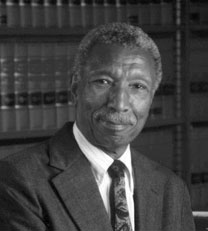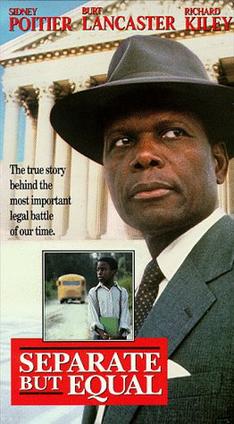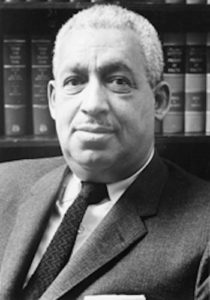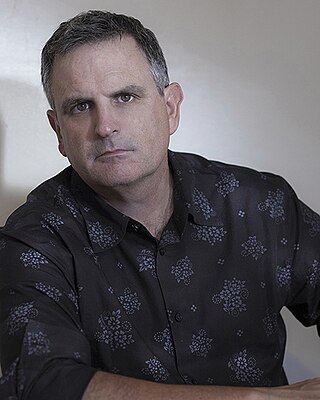
Thurgood Marshall was an American civil rights lawyer and jurist who served as an associate justice of the Supreme Court of the United States from 1967 until 1991. He was the Supreme Court's first African-American justice. Prior to his judicial service, he was an attorney who fought for civil rights, leading the NAACP Legal Defense and Educational Fund. Marshall was a prominent figure in the movement to end racial segregation in American public schools. He won 29 of the 32 civil rights cases he argued before the Supreme Court, culminating in the Court's landmark 1954 decision in Brown v. Board of Education, which rejected the separate but equal doctrine and held segregation in public education to be unconstitutional. President Lyndon B. Johnson appointed Marshall to the Supreme Court in 1967. A staunch liberal, he frequently dissented as the Court became increasingly conservative.
Chambers v. Florida, 309 U.S. 227 (1940), was a landmark United States Supreme Court case that dealt with the extent to which police pressure resulting in a criminal defendant's confession violates the Due Process Clause.
Sweatt v. Painter, 339 U.S. 629 (1950), was a U.S. Supreme Court case that successfully challenged the "separate but equal" doctrine of racial segregation established by the 1896 case Plessy v. Ferguson. The case was influential in the landmark case of Brown v. Board of Education four years later.
Charles Hamilton Houston was a prominent African-American lawyer, Dean of Howard University Law School, and NAACP first special counsel, or Litigation Director. A graduate of Amherst College and Harvard Law School, Houston played a significant role in dismantling Jim Crow laws, especially attacking segregation in schools and racial housing covenants. He earned the title "The Man Who Killed Jim Crow".

The NAACP Legal Defense and Educational Fund, Inc. is a leading United States civil rights organization and law firm based in New York City.
Moore et al. v. Dempsey, 261 U.S. 86 (1923), was a United States Supreme Court case in which the Court ruled 6–2 that the defendants' mob-dominated trials deprived them of due process guaranteed by the Due Process Clause of the Fourteenth Amendment. It reversed the district court's decision declining the petitioners' writ of habeas corpus. This case was a precedent for the Supreme Court's review of state criminal trials in terms of their compliance with the Bill of Rights.

Robert Lee Carter was an American lawyer, civil rights activist and a United States district judge of the United States District Court for the Southern District of New York.
A false confession is an admission of guilt for a crime which the individual did not commit. Although such confessions seem counterintuitive, they can be made voluntarily, perhaps to protect a third party, or induced through coercive interrogation techniques. When some degree of coercion is involved, studies have found that subjects with highly sophisticated intelligence or manipulated by their so called "friends" are more likely to make such confessions. Young people are particularly vulnerable to confessing, especially when stressed, tired, or traumatized, and have a significantly higher rate of false confessions than adults. Hundreds of innocent people have been convicted, imprisoned, and sometimes sentenced to death after confessing to crimes they did not commit—but years later, have been exonerated. It was not until several shocking false confession cases were publicized in the late 1980s, combined with the introduction of DNA evidence, that the extent of wrongful convictions began to emerge—and how often false confessions played a role in these.
The Trenton Six is the group name for six African-American defendants tried for murder of an elderly white shopkeeper in January 1948 in Trenton, New Jersey. The six young men were convicted in August 1948 by an all-white jury of the murder and sentenced to death.
Lisenba v. California, 314 U.S. 219 (1941), was a case in which the United States Supreme Court upheld the criminal conviction and death sentence imposed upon a man who confessed to murder after being detained for more than 24 hours, slapped and deprived of sleep and food. The petitioner argued that the confession was coerced, and that it violated his due process rights under the Fourteenth Amendment to the U.S. Constitution.

Willis Virgil McCall was sheriff of Lake County, Florida. He was elected for seven consecutive terms from 1944 to 1972. He gained national attention in the Groveland Case in 1949. In 1951, he shot two defendants in the case while he was transporting them to a new trial and killed one on the spot. Claiming self-defense, he was not indicted for this action. He also enforced anti-miscegenation laws and was a segregationist.
The Groveland Four were four African American men, Ernest Thomas, Charles Greenlee, Samuel Shepherd, and Walter Irvin. In July 1949, the four were accused of raping a white woman and severely beating her husband in Lake County, Florida. The oldest, Thomas, tried to elude capture and was killed that month. The others were put on trial. Shepard and Irvin received death sentences, and Greenlee was sentenced to life in prison. The events of the case led to serious questions about the arrests, allegedly coerced confessions and mistreatment, and the unusual sentencing following their convictions. Their incarceration was exacerbated by their systemic and unlawful treatment—including the death of Shepherd, and the near-fatal shooting of Irvin. Greenlee was paroled in 1962 and Irvin in 1968. All four were posthumously exonerated by the state of Florida in 2021.

Separate But Equal is a 1991 American two-part television miniseries depicting the landmark Supreme Court desegregation case Brown v. Board of Education, based on the phrase "Separate but equal". The film stars Sidney Poitier as lead NAACP attorney Thurgood Marshall, Richard Kiley as Chief Justice Earl Warren, Burt Lancaster as lawyer John W. Davis, Cleavon Little as lawyer and judge Robert L. Carter, and Lynne Thigpen as Ruth Alice Stovall.
Hale v. Kentucky, 303 U.S. 613 (1938), was a United States Supreme Court case relating to racial discrimination in the selection of juries for criminal trials. The case overturned the conviction of an African American man accused of murder because the lower court of Kentucky had systematically excluded African Americans from serving on the jury in the case. NAACP counsel, including Charles H. Houston, Leon A. Ransom and Thurgood Marshall, represented Hale.

William Robert Ming Jr. was an American lawyer, attorney with the National Association for the Advancement of Colored People (NAACP) and law professor at University of Chicago Law School and Howard University School of Law. He presided over the Freeman Field mutiny court-martials involving the Tuskegee Airmen. He is best remembered for being a member of the Brown v. Board of Education litigation team and for working on a number of the important cases leading to Brown, the decision in which the United States Supreme Court ruled de jure racial segregation a violation of the Equal Protection Clause of the Fourteenth Amendment of the United States Constitution.
Ashcraft v. Tennessee, 322 U.S. 143 (1944), is a United States Supreme Court case.
NAACP v. Button, 371 U.S. 415 (1963), is a 6-to-3 ruling by the Supreme Court of the United States which held that the reservation of jurisdiction by a federal district court did not bar the U.S. Supreme Court from reviewing a state court's ruling, and also overturned certain laws enacted by the state of Virginia in 1956 as part of the Stanley Plan and massive resistance, as violating the First and Fourteenth Amendments to the United States Constitution. The statutes here stricken down by the Supreme Court had expanded the definitions of the traditional common law crimes of champerty and maintenance, as well as barratry, and had been targeted at the NAACP and its civil rights litigation.

Gilbert Anthony King is an American writer and photographer. He is known best as the author of Devil in the Grove: Thurgood Marshall, the Groveland Boys, and the Dawn of a New America (2012), which won the Pulitzer Prize. His previous history was The Execution of Willie Francis: Race, Murder, and the Search for Justice in the American South (2008) and his most recent is Beneath a Ruthless Sun: A True Story of Violence, Race, and Justice Lost and Found (2018).
Brendan Ray Dassey is an American convicted murderer from Manitowoc County, Wisconsin, who at 16 confessed to being a party to first-degree murder, mutilation of a corpse, and second-degree sexual assault. He was sentenced to life in prison with the earliest possibility of parole in 2048. His videotaped interrogation and confession, which he recanted at trial, substantially contributed to his conviction. Parts were shown in the Netflix documentary series Making a Murderer (2015). The series examined the 2005–2007 investigation, prosecution, and trials of Dassey and his uncle, Steven Avery, both of whom were convicted of murdering the photographer Teresa Halbach on October 31, 2005.

Martin Armstrong Martin was an American criminal and civil rights attorney from Danville, Virginia who became the first African American trial attorney in the United States Department of Justice on May 31, 1943. He also became known for his appellate work for Odell Waller in 1942 and the Martinsville Seven in 1950-1951, and as a partner with Oliver Hill and future federal judge Spottswood Robinson in a law firm which assisted the National Association for the Advancement of Colored People in civil rights litigation in Virginia.








